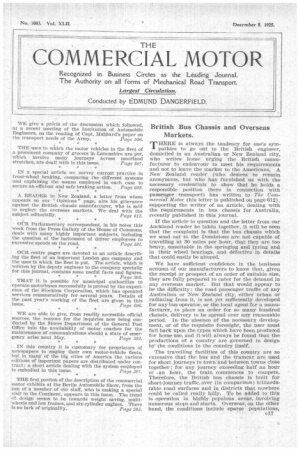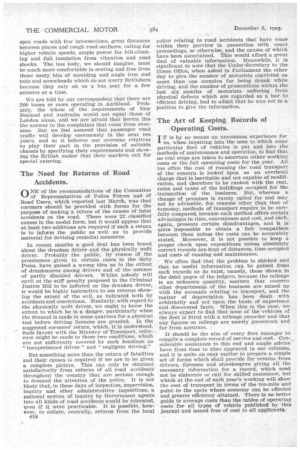British Bus Chassis and Overseas Markets.
Page 1

Page 2

If you've noticed an error in this article please click here to report it so we can fix it.
THERE is always the tendency for one's sympathies to go out to the British engineer, domiciled in an Australian or New Zealand city, who writes home urging the British manufacturer to endeavour to meet his requirements and not to leave the market to the Americans. A New Zealand reader (who desires to remain anonymous, but who has furnished us with the necessary credentials to show that he holds a responsible position there in connection with passenger transport) has written to The Commercial Motor (his letter is published on page 612), supporting the writer of an article, dealing with the requirements in bus chassis for Australia, recently published in this journal.
If the article in question and the letter from our Auckland reader be taken together, it will be seen that the complaint is that the bus chassis which we send out tO the Dominions are not capable of travelling at 30 miles per hour, that they are too heavy, unsuitable in the springing and tyring and, in their wheel bearings, and defective in details that could easily be altered.
We have sufficient confidence in the business acumen of our manufacturers to know that, given the receipt or prospect of an order of suitable size, they are fully prepared to cater for the demand in any overseas market. But that would appear to be the difficulty: the road passenger traffic of any Australian or New Zealand city, either urban or radiating from it, is not yet sufficiently developed for any bus operator, or the local agent for a manufacturer, to place an order for so many hundred chassis, delivery to be spread over any reasonable period. In the absence of the necessary development, or of the requisite foresight, the user must fall back upon the types which have been produced for home use, and it will always be found that the productions of a country are governed in design by the conditions in the country itself.
The travelling facilities of this country are so extensive that the bus and the tramcar are used for short journeys in town and between towns close together ; for any journey exceeding half an hour or .an hour, the train commences to compete. Therefore, the British bus chassis is built for short-journey traffic, over (in comparison) billiardstable road surfaces and in districts that nowhere could be called really hilly. To be added to this is operation in highly populous areas, involving numerous stops and starts. Overseas, on the Other hand, the conditions include sparse populations, open roads with few intersections, great distances between places and rough road surfaces, calling for higher vehicle speeds, ample power for hill-climbing and full insulation from vibration and road shocks. The bus body, we should imagine, must be much more comfortable in seating and free from those nasty bits of moulding and angle iron and nuts and screwheads which do not worry Britishers because they only sit on a bus seat for a few minutes at a time.
We are told by our correspondent that there are • 200 buses or more operating in Auckland. Probably, the whole of the requirements of New Zealand and Australia would not equal those of London alone, and we are afraid that herein lies the answer to the complaints that come from overseas. But we feel assured that passenger road traffic • will develop enormously in the next ten years, and so it behoves our overseas relatives to play their part in the provision of suitable chassis by specifying their requirements and showing the British maker that their markets call for special catering.
































